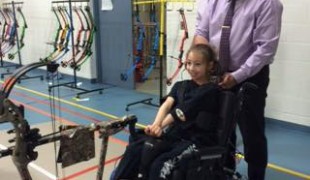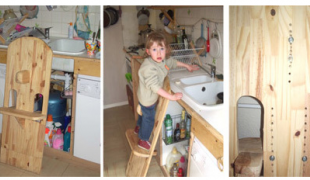- 3762
- 326
- 11
- 7
- 0
- Help Ukraine
About the solution
Abby needed something that allowed to keep her feet positioned and stable on the wheelchair footrest. She is paralysed from the chest down after having sustained a spinal cord injury. The girl has limited movement her arms and no fine motor control in her fingers.
“I have biceps but no triceps and very little core control. My problem is that when I am sitting in my wheelchair, I have spasms quite frequently that cause my feet to move out of position. When they are not in the right position, I am in quite a bit of pain. I am always calling my parents into my room to move my feet. And also because of this, I can never be left alone. That is quite a hardship on my parents”, she explained, when she reached out to May We Help.
So Ray, a volunteer from May We Help (an organisation that develops gadgets to increase the autonomy level of disabled people), created her a footrest that enables her to move her feet back into position by herself. He used plastic and hardware, and Abby got her device in 2015.
“I wanted to let you know that the modification you made had worked out beyond our expectations! When she has leg spasms now, the feet “magically” return to their proper position about 80% of the time. It has given her more independence as now she feels confident to be left alone for an hour or two at a time. And it has certainly helped out us as well, as we don’t have to worry about her being alone as much, and we don’t have to run and fix her feet all of the time now”, her family said.
Adapted from: https://bit.ly/31yHjZa
This solution shall not include mention to the use of drugs, chemicals or biologicals (including food); invasive devices; offensive, commercial or inherently dangerous content. This solution was not medically validated. Proceed with caution! If you have any doubts, please consult with a health professional.
DISCLAIMER: This story was written by someone who is not the author of the solution, therefore please be advised that, although it was written with the utmost respect for the innovation and the innovator, there can be some incorrect statements. If you find any errors please contact the patient Innovation team via info@patient-innovation.com
-
-
618
-
0
-
8367

Father creates gadgets adapted for people with cerebral palsy
MOVING IN A WHEELCHAIR: Moving using a wheelchair.
Playing
Gardening
Social interaction
Cerebral Palsy
Educational/Leisure device (book, toy, game...)
Assistive Daily Life Device (to help ADL)
Muscle cramps or spasms
Difficulty coordinating movements
Trouble with fine motor skills (e.g., writing, buttoning clothes)
Twitching or involuntary movements (myoclonus)
Fatigue
Restoring mobility
Promoting self-management
Managing Neurological Disorders
Promoting inclusivity and social integration
Caregiving Support
Neurology
Pediatrics
Physical Medicine and Rehabilitation
Canada
-
-
-
354
-
0
-
4723

Step articulated and mobile
MOVING IN A WHEELCHAIR: Moving using a wheelchair.
Traveling
Urban exploration
Paralysis
Assistive Daily Life Device (to help ADL)
Walking Aid (wheelchair/walker/crutches)
Restoring mobility
Promoting self-management
Managing Neurological Disorders
Building Supportive Community Relationships
Promoting inclusivity and social integration
Recovering from Traumatic Injuries
Maintaining Balance and Mobility
To improve Treatment/Therapy
Raise awareness
Caregiving Support
Neurology
Orthopedics
Rheumatology
Portugal
-
-
-
679
-
0
-
17955

Parents develop structure to help their daughter stand
STANDING UP: Standing up from a seated position
WALKING: Walking
Cerebral Palsy
Assistive Daily Life Device (to help ADL)
Gait abnormalities (e.g., walking difficulties, unsteady gait)
Tremors
Muscle cramps or spasms
Stiffness or rigidity (difficulty moving)
Paralysis of the legs and lower body
Muscle weakness
Twitching or involuntary movements (myoclonus)
Fatigue
Restoring mobility
Promoting self-management
Managing Neurological Disorders
Maintaining Balance and Mobility
Preventing (Vaccination, Protection, Falls, Research/Mapping)
Caregiving Support
General and Family Medicine
Neurology
Pediatrics
France
-
 en
en